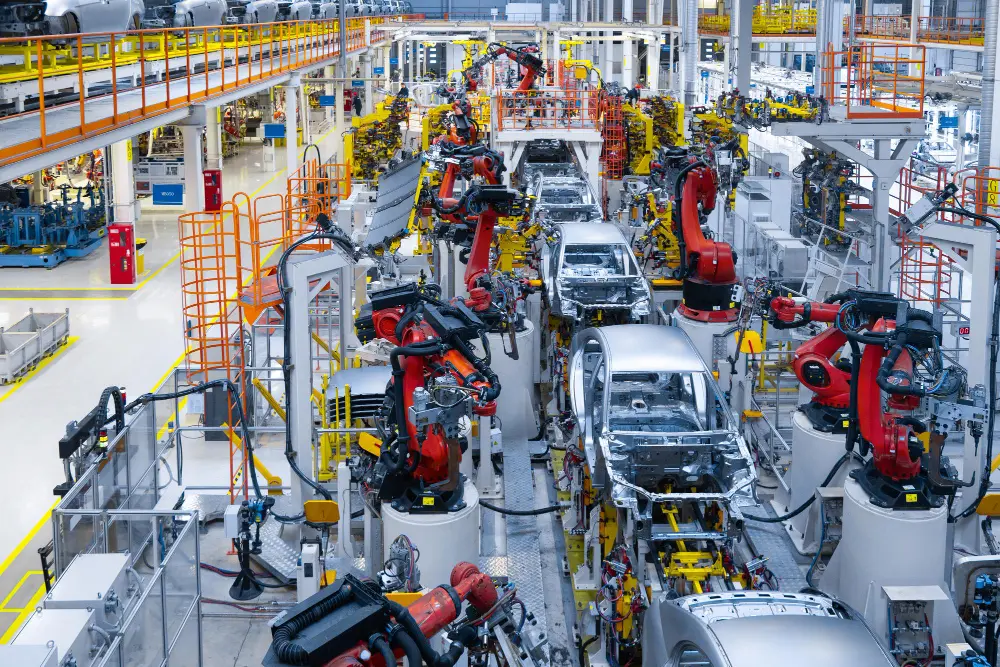Optimizing Demand Forecasting in Automotive Supply Chain

Demand forecasting plays a critical role in the automotive supply chain. It allows you to predict future demand with greater accuracy, ensuring the right inventory levels and production schedules. Without optimization, inefficiencies arise, leading to overstocking or stockouts that disrupt operations. Advanced technologies like AI have revolutionized this process. They enable you to analyze vast datasets, identify patterns, and make data-driven decisions. These tools not only improve forecasting but also enhance supply chain resilience in a competitive market.
Actionable Strategies for Demand Forecasting Optimization

Leveraging AI-Based Demand Forecasting
Predictive Analytics for Market Trends
Predictive analytics plays a pivotal role in enhancing demand planning. By analyzing historical data and market trends, you can anticipate shifts in customer behavior and align production schedules accordingly. AI-powered solutions enable you to process vast datasets, identifying patterns that traditional methods often overlook. For instance, manufacturers using AI-driven predictive analytics have reported significant improvements in demand forecasting accuracy. This approach not only reduces inventory mismanagement but also supports strategic decision-making in procurement and production planning.
A case study revealed that implementing AI-based demand forecasting saved a manufacturer $10 million annually by optimizing inventory levels.
AI's ability to analyze multiple data points ensures more personalized demand prediction, giving you a competitive advantage in the market.
Real-Time Adjustments Using Machine Learning
Machine learning enhances your ability to make real-time adjustments in demand forecasting. By continuously learning from new data, these systems adapt to changing market conditions and consumer preferences. This dynamic approach ensures accurate demand forecasting even in volatile markets.
For example, AI-based demand forecasting systems can analyze real-time insights from sales data, weather patterns, and economic indicators to adjust forecasts instantly. This capability minimizes the risk of overstocking or stockouts, improving operational efficiency and customer satisfaction. Manufacturers leveraging machine learning have also seen enhanced supply chain optimization, as these tools streamline inventory management and logistics.
Utilizing IoT for Data-Driven Insights
Monitoring Vehicle Usage and Maintenance
IoT devices provide real-time insights into vehicle usage and maintenance needs. By collecting data from sensors embedded in vehicles, you can predict demand for replacement parts and maintenance services. This proactive approach ensures that you meet customer needs promptly, enhancing satisfaction and retention.
IoT-enabled systems also allow you to monitor equipment performance, identifying potential issues before they escalate. This reduces downtime and improves operational efficiency across the supply chain.
Real-Time Supply Chain Visibility
IoT enhances supply chain visibility by providing real-time insights into inventory levels, transportation conditions, and delivery schedules. Intelligent containers equipped with IoT sensors monitor critical factors like temperature and humidity during transit, ensuring product integrity.
Real-time data analysis also enables route optimization, reducing transportation costs and environmental impact. By integrating IoT into your demand planning processes, you can align production with actual demand, avoiding overstocking or understocking. This alignment supports strategic decision-making and strengthens your competitive advantage.
Advanced Data Analytics for Automotive Supply Chains
Historical Data Integration and Scenario Planning
Integrating historical data into your demand planning models allows you to identify trends and prepare for future scenarios. Advanced analytics tools enable you to simulate various market conditions, helping you make informed decisions.
For example, analyzing past sales data alongside external factors like economic trends ensures more accurate demand forecasting. This approach minimizes risks and enhances operational efficiency, giving you a competitive edge in the automotive industry.
Simulation Models for Demand Fluctuations
Simulation models help you predict how demand might fluctuate under different circumstances. By testing various scenarios, you can identify potential challenges and develop strategies to address them.
These models also support personalized demand prediction by considering factors like regional preferences and seasonal trends. This level of precision ensures that your supply chain remains agile and responsive to market changes.
Collaboration Across the Supply Chain
Data Sharing Between Manufacturers and Suppliers
Collaboration between manufacturers and suppliers plays a vital role in optimizing demand forecasting. Sharing data across the supply chain ensures that all stakeholders have access to accurate and timely information. This transparency allows you to align production schedules with actual demand, reducing inefficiencies and improving overall performance.
When manufacturers and suppliers share demand forecasting data, several benefits emerge:
Identification of improvement areas through shared data.
Streamlined customer service through collaborative analytics.
These advantages translate into measurable improvements. For example:
Metric | Description |
|---|---|
Improved Inventory Management | Helps maintain optimal inventory levels, reducing stockouts and overstock situations. |
Cost Reduction | Aligning inventory with demand forecasts cuts costs associated with excess inventory. |
Risk Mitigation | Identifies potential risks and prepares for supply chain disruptions, enhancing resilience. |
By fostering data sharing, you can create a more agile and responsive supply chain. This approach not only minimizes risks but also ensures that resources are utilized effectively.
Real-World Examples of Optimized Demand Forecasting

Case Study: AI-Based Demand Forecasting in Automotive Manufacturing
AI-based demand forecasting has transformed the automotive industry by addressing inefficiencies in inventory management. A leading automotive manufacturer faced challenges with inaccurate demand predictions, resulting in excess inventory and high costs. By implementing AI-driven forecasting, the company achieved remarkable results:
Saved $10 million annually in inventory costs.
Reduced forecasting errors by 50%, leading to optimized stock levels for over 200,000 replacement parts.
This success highlights the power of AI in improving demand accuracy. The manufacturer not only streamlined operations but also achieved increased profitability by minimizing waste and aligning inventory with actual demand. These advancements demonstrate how AI can revolutionize automotive supply chains, ensuring better resource allocation and cost efficiency.
Case Study: IoT-Driven Inventory Management in Automotive Supply Chains
IoT technology has redefined inventory management in the automotive sector. By integrating IoT-enabled sensors, companies gain real-time visibility into inventory levels and supply chain conditions. For example, IoT devices monitor vehicle usage and maintenance needs, allowing manufacturers to predict demand for replacement parts accurately.
This proactive approach reduces stockouts and ensures timely availability of critical components. Additionally, IoT enhances supply chain transparency by tracking transportation conditions and delivery schedules. These insights enable manufacturers to optimize inventory management, reduce costs, and improve customer satisfaction. The adoption of IoT in the automotive industry has proven essential for achieving increased profitability and operational efficiency.
Case Study: JUSDA's Role in Enhancing Supply Chain Efficiency
JUSDA has emerged as a leader in optimizing demand forecasting for the automotive industry. By leveraging its Supply Chain Management Collaboration Platform, JUSDA has delivered measurable improvements in supply chain performance. Key metrics include:
Performance Metric | Description |
|---|---|
Enhanced ability to predict future demand accurately, leading to better inventory management. | |
Optimized Stock Levels | Reduction in excess inventory and stockouts, improving overall supply chain efficiency. |
Enhanced Supplier Management | Better collaboration and communication with suppliers, resulting in more reliable supply chains. |
Proactive Response to Market Changes | Ability to adjust operations quickly based on real-time data and market trends. |
These achievements underscore JUSDA's commitment to innovation and efficiency. By integrating advanced technologies, JUSDA has helped automotive manufacturers achieve increased profitability while maintaining a resilient and agile supply chain.

JUSDA Solutions
To provide you with professional solutions and quotations.
Step-by-Step Guide to Implementing Demand Forecasting Solutions
Step 1: Data Collection and Organization
Effective demand forecasting begins with robust data collection and preparation. This step ensures that you have accurate and relevant information to build reliable forecasts. Follow these six statistical guidelines to organize your data effectively:
Identify the goal(s) of the forecast.
Determine what information you have and what you can get.
Set and execute on a data collection plan.
Apply appropriate forecasting methods to the information.
Interpret results in context.
Track your results — and iterate.
By adhering to these steps, you create a solid foundation for your forecasting process. For example, collecting historical sales data, vehicle parts information, and dealer insights allows you to align your forecasts with market demand. This organized approach minimizes errors and ensures that your supply chain operates efficiently.
Tip: Regularly update your data to reflect current market conditions and consumer preferences. This practice enhances the accuracy of your forecasts.
Step 2: Developing AI-Based Forecasting Models
AI model development is a critical step in optimizing demand forecasting. Advanced AI algorithms analyze vast datasets to identify patterns and predict future demand with precision. To build effective models, consider these quantitative benchmarks:
Description | |
|---|---|
Historical Data | Utilizes past data on replacement parts to inform future production needs. |
Vehicle Parts Information | Analyzes data related to various vehicle parts to optimize inventory levels. |
Dealer Information | Incorporates dealer data to enhance demand forecasting accuracy. |
Production Year | Considers the production year to align inventory with market demand. |
Decaying Factor Models | Uses models to determine inventory levels based on peak demand and product lifecycle. |
These benchmarks ensure that your AI models are tailored to the unique demands of the automotive industry. For instance, incorporating dealer data improves forecasting accuracy by aligning production schedules with real-time market needs. This step not only enhances operational efficiency but also reduces costs associated with overproduction or stockouts.
Step 3: Integrating IoT and Advanced Analytics
Integration and deployment of IoT and advanced analytics transform your supply chain into a data-driven ecosystem. IoT devices provide real-time insights into inventory levels, transportation conditions, and vehicle usage. These insights enable you to refine demand forecasts and respond quickly to market changes.
Key metrics to evaluate the success of IoT integration include:
Metric | Description |
|---|---|
Includes all direct and indirect costs associated with materials and products, helping identify hidden costs. | |
Quality of Inputs and Outputs | Affects customer satisfaction and profitability, measured by tracking defects, rework, and returns. |
IoT also enhances route planning and inventory optimization, ensuring that your supply chain remains agile and efficient. Advanced analytics derived from IoT data allow you to spot trends and predict market shifts, giving you a competitive edge. By integrating these technologies, you create a responsive supply chain that adapts to dynamic market conditions.
Note: Real-time data from IoT devices improves decision-making, enabling you to align production with actual demand and reduce waste.
Step 4: Continuous Monitoring and Improvement
Continuous monitoring and improvement are essential for maintaining the accuracy and efficiency of your demand forecasting processes. Market conditions, consumer preferences, and supply chain dynamics constantly evolve. Regularly reviewing your forecasting models ensures they remain relevant and effective.
Start by implementing a system for real-time performance tracking. Use key performance indicators (KPIs) such as forecast accuracy, inventory turnover, and lead times to measure the effectiveness of your demand planning. For example:
KPI | Purpose |
|---|---|
Forecast Accuracy | Measures how closely forecasts align with actual demand. |
Inventory Turnover | Tracks how efficiently inventory is sold and replaced. |
Lead Times | Evaluates the time taken to fulfill customer orders. |
You should also establish a feedback loop. This allows you to identify discrepancies between forecasts and actual outcomes. Use this information to refine your models and address any gaps. Machine learning algorithms can assist by adapting to new data and improving predictions over time.
Tip: Schedule regular audits of your forecasting processes. This ensures that your strategies align with current market trends and operational goals.
Encourage collaboration across departments. Sharing insights between sales, production, and logistics teams fosters a unified approach to demand planning. This collaboration minimizes errors and enhances overall supply chain performance.
Step 5: Leveraging JUSDA's Supply Chain Solutions
JUSDA offers advanced tools and platforms to optimize your demand forecasting efforts. Its Supply Chain Management Collaboration Platform integrates cutting-edge technologies like AI, IoT, and big data analytics. These tools provide real-time insights, enabling you to make informed decisions and respond quickly to market changes.
With JUSDA, you gain access to features like demand forecasting coordination, inventory visibility, and transport tracking. These capabilities streamline your operations and improve forecasting accuracy. For instance, the platform's predictive analytics tools analyze historical data and market trends to deliver precise demand predictions.
JUSDA's solutions also enhance collaboration. The platform connects manufacturers, suppliers, and logistics providers, ensuring seamless data sharing and communication. This integration reduces inefficiencies and strengthens your supply chain resilience.
Note: By leveraging JUSDA's expertise, you can achieve cost savings, improve operational efficiency, and enhance customer satisfaction. Explore their solutions to transform your supply chain into a competitive advantage.
Demand forecasting serves as the backbone of the automotive supply chain. It ensures production aligns with demand, prevents stock imbalances, and reduces operational costs.
Adjusting inventory levels avoids stockouts and excess storage costs.
Collaborating with suppliers ensures timely material availability.
Anticipating disruptions strengthens risk management strategies.
Leveraging AI and IoT transforms forecasting accuracy. These technologies provide real-time insights, enabling proactive decision-making and seamless collaboration across the supply chain.
Explore JUSDA's innovative solutions to optimize your forecasting processes and achieve operational excellence.
FAQ
What is the role of AI in demand forecasting for the automotive supply chain?
AI enhances demand forecasting by analyzing large datasets, identifying patterns, and predicting future trends. It enables you to make data-driven decisions, improve forecast accuracy, and adapt to market changes in real time. This ensures better inventory management and operational efficiency.
How does IoT improve supply chain visibility?
IoT devices provide real-time data on inventory levels, transportation conditions, and vehicle usage. This transparency allows you to monitor supply chain activities, optimize routes, and ensure timely deliveries. IoT-driven insights help you align production with actual demand, reducing inefficiencies.
Why is collaboration important in demand forecasting?
Collaboration ensures that manufacturers, suppliers, and stakeholders share accurate data. This alignment improves forecast accuracy, reduces risks, and enhances supply chain resilience. By working together, you can respond quickly to market changes and maintain optimal inventory levels.
What are the key benefits of using JUSDA's solutions?
JUSDA's solutions offer advanced tools like AI and IoT integration, real-time data sharing, and predictive analytics. These features help you optimize demand forecasting, reduce costs, and improve supply chain efficiency. The platform also fosters collaboration, ensuring seamless operations across stakeholders.
How can you start optimizing demand forecasting in your supply chain?
Begin by collecting and organizing accurate data. Implement AI-based forecasting models and integrate IoT for real-time insights. Collaborate with stakeholders to align forecasting models. Consider leveraging JUSDA's solutions for advanced tools and expert support to streamline your processes.
See Also
Maximizing Efficiency in Your Automotive Supply Chain
Enhancing Strategies for High-Tech Manufacturing Supply Chain Challenges
Expert Advice for Overcoming Automotive Supply Chain Challenges
